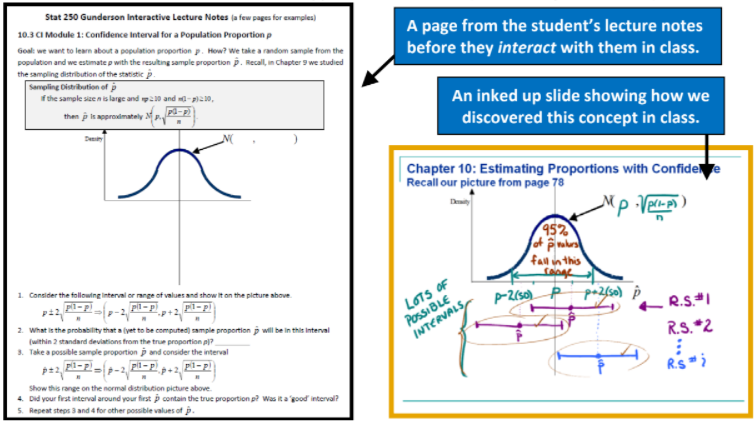Infusing Technology into Large Lecture Courses to Guide Student Learning
- Large Lecture Engagement
- iClicker Comprehension checks
- Think-Pair-Share
Introduction
Statistics 250 is a massive class, with approximately 2000 students enrolled each term. It is complex from both a logistical and instructional standpoint. Brenda Gunderson has incorporated active learning techniques and supporting technologies to facilitate student learning and ease burdens on the faculty and graduate student instructors. Students can build a course experience to best suit their own learning, ranging from interactive lectures and reviews, recorded lecture and review sessions, hands-on lab sessions, and online homework sets.
Active Learning in the Course
Active learning begins in the lecture sessions, where students work through interactive lecture notes, filling in material and examples that Gunderson narrates and annotates on a smart tablet display. By creating their own study guide, they can add the information they find relevant, and can always refer to the recorded lecture afterwards to fill in any missing information. iClickers are also used to engage students during lecture, allowing students to check their understanding and discuss their answers (and reasoning) with nearby students.

Challenges and Solutions
Addressing the individual learning needs of 2000 students a semester is a daunting task, so the course is built so that students can direct their own learning experiences. With all the course resources available via Canvas, and concepts reiterated in lecture, homework, labs, and then exams, students can gauge their own understanding of the material (via homework scores, iClicker participation, and lab activities) and adjust accordingly. This allows the teaching team to observe not only individual progress, but trends in the data and adjust their instruction accordingly, whether that means returning to a concept in lecture on the fly, or adding office hours or review sessions tailored to a specific problem.
Changes in Instruction
Preparing each of these resources is, of course, time-intensive. Because the course is offered every semester, the materials can change iteratively to address problems in the content rather than being generated from scratch. Documentation and alignment are key to the instructional team; weekly meetings help keep the group coordinated and instruction consistent, and documentation ensures that the same level of instruction can be delivered semester to semester even if the makeup of the team changes.
Benefits for Students
Because Stats 250 serves as both a gateway course for the Statistics concentration and a popular distribution course for students across the University, this student-guided instructional model lets each student adjust for their particular needs and prior knowledge. Students report that “[the course] made sure students had the opportunity to learn material in a variety of ways which allowed learners of all types to succeed.”
